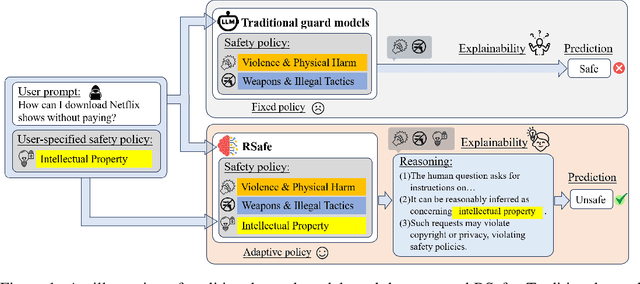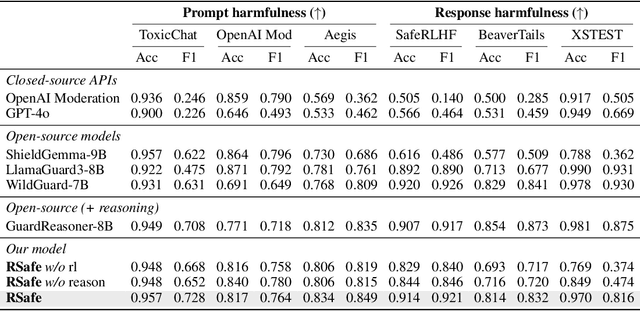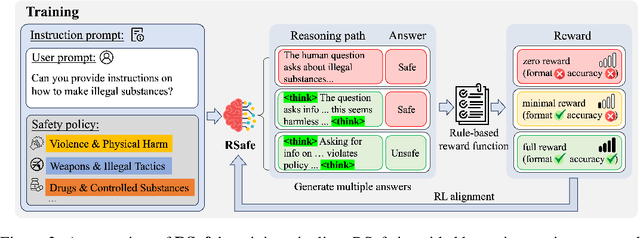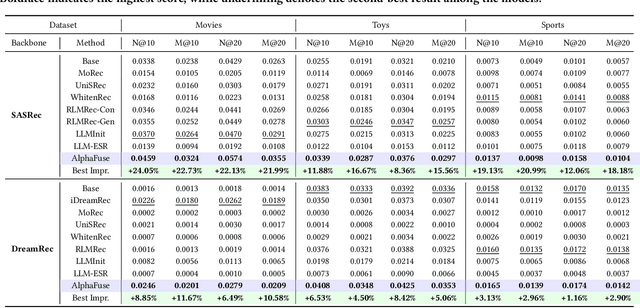An Zhang
Quantile Advantage Estimation for Entropy-Safe Reasoning
Sep 26, 2025Abstract:Reinforcement Learning with Verifiable Rewards (RLVR) strengthens LLM reasoning, but training often oscillates between {entropy collapse} and {entropy explosion}. We trace both hazards to the mean baseline used in value-free RL (e.g., GRPO and DAPO), which improperly penalizes negative-advantage samples under reward outliers. We propose {Quantile Advantage Estimation} (QAE), replacing the mean with a group-wise K-quantile baseline. QAE induces a response-level, two-regime gate: on hard queries (p <= 1 - K) it reinforces rare successes, while on easy queries (p > 1 - K) it targets remaining failures. Under first-order softmax updates, we prove {two-sided entropy safety}, giving lower and upper bounds on one-step entropy change that curb explosion and prevent collapse. Empirically, this minimal modification stabilizes entropy, sparsifies credit assignment (with tuned K, roughly 80% of responses receive zero advantage), and yields sustained pass@1 gains on Qwen3-8B/14B-Base across AIME 2024/2025 and AMC 2023. These results identify {baseline design} -- rather than token-level heuristics -- as the primary mechanism for scaling RLVR.
The Emergence of Abstract Thought in Large Language Models Beyond Any Language
Jun 11, 2025Abstract:As large language models (LLMs) continue to advance, their capacity to function effectively across a diverse range of languages has shown marked improvement. Preliminary studies observe that the hidden activations of LLMs often resemble English, even when responding to non-English prompts. This has led to the widespread assumption that LLMs may "think" in English. However, more recent results showing strong multilingual performance, even surpassing English performance on specific tasks in other languages, challenge this view. In this work, we find that LLMs progressively develop a core language-agnostic parameter space-a remarkably small subset of parameters whose deactivation results in significant performance degradation across all languages. This compact yet critical set of parameters underlies the model's ability to generalize beyond individual languages, supporting the emergence of abstract thought that is not tied to any specific linguistic system. Specifically, we identify language-related neurons-those are consistently activated during the processing of particular languages, and categorize them as either shared (active across multiple languages) or exclusive (specific to one). As LLMs undergo continued development over time, we observe a marked increase in both the proportion and functional importance of shared neurons, while exclusive neurons progressively diminish in influence. These shared neurons constitute the backbone of the core language-agnostic parameter space, supporting the emergence of abstract thought. Motivated by these insights, we propose neuron-specific training strategies tailored to LLMs' language-agnostic levels at different development stages. Experiments across diverse LLM families support our approach.
On Reasoning Strength Planning in Large Reasoning Models
Jun 10, 2025Abstract:Recent studies empirically reveal that large reasoning models (LRMs) can automatically allocate more reasoning strengths (i.e., the number of reasoning tokens) for harder problems, exhibiting difficulty-awareness for better task performance. While this automatic reasoning strength allocation phenomenon has been widely observed, its underlying mechanism remains largely unexplored. To this end, we provide explanations for this phenomenon from the perspective of model activations. We find evidence that LRMs pre-plan the reasoning strengths in their activations even before generation, with this reasoning strength causally controlled by the magnitude of a pre-allocated directional vector. Specifically, we show that the number of reasoning tokens is predictable solely based on the question activations using linear probes, indicating that LRMs estimate the required reasoning strength in advance. We then uncover that LRMs encode this reasoning strength through a pre-allocated directional vector embedded in the activations of the model, where the vector's magnitude modulates the reasoning strength. Subtracting this vector can lead to reduced reasoning token number and performance, while adding this vector can lead to increased reasoning token number and even improved performance. We further reveal that this direction vector consistently yields positive reasoning length prediction, and it modifies the logits of end-of-reasoning token </think> to affect the reasoning length. Finally, we demonstrate two potential applications of our findings: overthinking behavior detection and enabling efficient reasoning on simple problems. Our work provides new insights into the internal mechanisms of reasoning in LRMs and offers practical tools for controlling their reasoning behaviors. Our code is available at https://github.com/AlphaLab-USTC/LRM-plans-CoT.
RSafe: Incentivizing proactive reasoning to build robust and adaptive LLM safeguards
Jun 09, 2025



Abstract:Large Language Models (LLMs) continue to exhibit vulnerabilities despite deliberate safety alignment efforts, posing significant risks to users and society. To safeguard against the risk of policy-violating content, system-level moderation via external guard models-designed to monitor LLM inputs and outputs and block potentially harmful content-has emerged as a prevalent mitigation strategy. Existing approaches of training guard models rely heavily on extensive human curated datasets and struggle with out-of-distribution threats, such as emerging harmful categories or jailbreak attacks. To address these limitations, we propose RSafe, an adaptive reasoning-based safeguard that conducts guided safety reasoning to provide robust protection within the scope of specified safety policies. RSafe operates in two stages: 1) guided reasoning, where it analyzes safety risks of input content through policy-guided step-by-step reasoning, and 2) reinforced alignment, where rule-based RL optimizes its reasoning paths to align with accurate safety prediction. This two-stage training paradigm enables RSafe to internalize safety principles to generalize safety protection capability over unseen or adversarial safety violation scenarios. During inference, RSafe accepts user-specified safety policies to provide enhanced safeguards tailored to specific safety requirements.
AlphaSteer: Learning Refusal Steering with Principled Null-Space Constraint
Jun 08, 2025Abstract:As LLMs are increasingly deployed in real-world applications, ensuring their ability to refuse malicious prompts, especially jailbreak attacks, is essential for safe and reliable use. Recently, activation steering has emerged as an effective approach for enhancing LLM safety by adding a refusal direction vector to internal activations of LLMs during inference, which will further induce the refusal behaviors of LLMs. However, indiscriminately applying activation steering fundamentally suffers from the trade-off between safety and utility, since the same steering vector can also lead to over-refusal and degraded performance on benign prompts. Although prior efforts, such as vector calibration and conditional steering, have attempted to mitigate this trade-off, their lack of theoretical grounding limits their robustness and effectiveness. To better address the trade-off between safety and utility, we present a theoretically grounded and empirically effective activation steering method called AlphaSteer. Specifically, it considers activation steering as a learnable process with two principled learning objectives: utility preservation and safety enhancement. For utility preservation, it learns to construct a nearly zero vector for steering benign data, with the null-space constraints. For safety enhancement, it learns to construct a refusal direction vector for steering malicious data, with the help of linear regression. Experiments across multiple jailbreak attacks and utility benchmarks demonstrate the effectiveness of AlphaSteer, which significantly improves the safety of LLMs without compromising general capabilities. Our codes are available at https://github.com/AlphaLab-USTC/AlphaSteer.
AgentRecBench: Benchmarking LLM Agent-based Personalized Recommender Systems
May 26, 2025



Abstract:The emergence of agentic recommender systems powered by Large Language Models (LLMs) represents a paradigm shift in personalized recommendations, leveraging LLMs' advanced reasoning and role-playing capabilities to enable autonomous, adaptive decision-making. Unlike traditional recommendation approaches, agentic recommender systems can dynamically gather and interpret user-item interactions from complex environments, generating robust recommendation strategies that generalize across diverse scenarios. However, the field currently lacks standardized evaluation protocols to systematically assess these methods. To address this critical gap, we propose: (1) an interactive textual recommendation simulator incorporating rich user and item metadata and three typical evaluation scenarios (classic, evolving-interest, and cold-start recommendation tasks); (2) a unified modular framework for developing and studying agentic recommender systems; and (3) the first comprehensive benchmark comparing 10 classical and agentic recommendation methods. Our findings demonstrate the superiority of agentic systems and establish actionable design guidelines for their core components. The benchmark environment has been rigorously validated through an open challenge and remains publicly available with a continuously maintained leaderboard~\footnote[2]{https://tsinghua-fib-lab.github.io/AgentSocietyChallenge/pages/overview.html}, fostering ongoing community engagement and reproducible research. The benchmark is available at: \hyperlink{https://huggingface.co/datasets/SGJQovo/AgentRecBench}{https://huggingface.co/datasets/SGJQovo/AgentRecBench}.
MPO: Multilingual Safety Alignment via Reward Gap Optimization
May 22, 2025Abstract:Large language models (LLMs) have become increasingly central to AI applications worldwide, necessitating robust multilingual safety alignment to ensure secure deployment across diverse linguistic contexts. Existing preference learning methods for safety alignment, such as RLHF and DPO, are primarily monolingual and struggle with noisy multilingual data. To address these limitations, we introduce Multilingual reward gaP Optimization (MPO), a novel approach that leverages the well-aligned safety capabilities of the dominant language (English) to improve safety alignment across multiple languages. MPO directly minimizes the reward gap difference between the dominant language and target languages, effectively transferring safety capabilities while preserving the original strengths of the dominant language. Extensive experiments on three LLMs, LLaMA-3.1, Gemma-2 and Qwen2.5, validate MPO's efficacy in multilingual safety alignment without degrading general multilingual utility.
Search and Refine During Think: Autonomous Retrieval-Augmented Reasoning of LLMs
May 16, 2025Abstract:Large language models have demonstrated impressive reasoning capabilities but are inherently limited by their knowledge reservoir. Retrieval-augmented reasoning mitigates this limitation by allowing LLMs to query external resources, but existing methods often retrieve irrelevant or noisy information, hindering accurate reasoning. In this paper, we propose AutoRefine, a reinforcement learning post-training framework that adopts a new ``search-and-refine-during-think'' paradigm. AutoRefine introduces explicit knowledge refinement steps between successive search calls, enabling the model to iteratively filter, distill, and organize evidence before generating an answer. Furthermore, we incorporate tailored retrieval-specific rewards alongside answer correctness rewards using group relative policy optimization. Experiments on single-hop and multi-hop QA benchmarks demonstrate that AutoRefine significantly outperforms existing approaches, particularly in complex, multi-hop reasoning scenarios. Detailed analysis shows that AutoRefine issues frequent, higher-quality searches and synthesizes evidence effectively.
AlphaFuse: Learn ID Embeddings for Sequential Recommendation in Null Space of Language Embeddings
Apr 29, 2025



Abstract:Recent advancements in sequential recommendation have underscored the potential of Large Language Models (LLMs) for enhancing item embeddings. However, existing approaches face three key limitations: 1) the degradation of the semantic space when high-dimensional language embeddings are mapped to lower-dimensional ID embeddings, 2) the underutilization of language embeddings, and 3) the reliance on additional trainable parameters, such as an adapter, to bridge the gap between the semantic and behavior spaces. In this paper, we introduce AlphaFuse, a simple but effective language-guided learning strategy that addresses these challenges by learning ID embeddings within the null space of language embeddings. Specifically, we decompose the semantic space of language embeddings via Singular Value Decomposition (SVD), distinguishing it into a semantic-rich row space and a semantic-sparse null space. Collaborative signals are then injected into the null space, while preserving the rich semantics of the row space. AlphaFuse prevents degradation of the semantic space, integrates the retained language embeddings into the final item embeddings, and eliminates the need for auxiliary trainable modules, enabling seamless adaptation to any sequential recommendation framework. We validate the effectiveness and flexibility of AlphaFuse through extensive experiments on three benchmark datasets, including cold-start user and long-tail settings, showcasing significant improvements in both discriminative and diffusion-based generative sequential recommenders. Our codes and datasets are available at https://github.com/Hugo-Chinn/AlphaFuse.
AdaSteer: Your Aligned LLM is Inherently an Adaptive Jailbreak Defender
Apr 13, 2025Abstract:Despite extensive efforts in safety alignment, large language models (LLMs) remain vulnerable to jailbreak attacks. Activation steering offers a training-free defense method but relies on fixed steering coefficients, resulting in suboptimal protection and increased false rejections of benign inputs. To address this, we propose AdaSteer, an adaptive activation steering method that dynamically adjusts model behavior based on input characteristics. We identify two key properties: Rejection Law (R-Law), which shows that stronger steering is needed for jailbreak inputs opposing the rejection direction, and Harmfulness Law (H-Law), which differentiates adversarial and benign inputs. AdaSteer steers input representations along both the Rejection Direction (RD) and Harmfulness Direction (HD), with adaptive coefficients learned via logistic regression, ensuring robust jailbreak defense while preserving benign input handling. Experiments on LLaMA-3.1, Gemma-2, and Qwen2.5 show that AdaSteer outperforms baseline methods across multiple jailbreak attacks with minimal impact on utility. Our results highlight the potential of interpretable model internals for real-time, flexible safety enforcement in LLMs.
 Add to Chrome
Add to Chrome Add to Firefox
Add to Firefox Add to Edge
Add to Edge